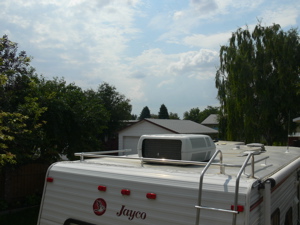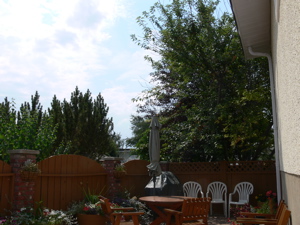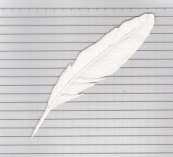 |
|
||||||||||||||
| Links to Notebook Pages: | Model Trains |
Wednesday August 9, 2006 7:10 am Lethbridge Alberta Sunrise 6:13 Sunset 9:01 Hours of daylight: 14:48
 |
 |
From rear window |
South patio |
Both images taken at 2:15 PM |
|
A. Morning Musings
7:10 am It is + 21 C at the moment, with a forecast high of + 24 C. The sky is basically overcast although the forecast is for only a 40% chance of showers.
B. Plan
Immediate Health Walk & exercise 1 hr Mathematics Read "The Computational Beauty of Nature" Chap 3 1 hr Model Trains Wire Lower Mainline Reversing loop track; wire one turnout 3 hr Assemble wooden trestle kit 2 hr Build oil refinery diorama: glue oil tank berms to base 1 hr Look for Critical Path software on PC and install it on my MacBook Pro 1 hr Create an Adepttracker project management file 3 hr Literature Continue reading "Ada Blackjack" 1 hr Later Chores Investigate water softeners for home 1 hr Technology Read manual for cell phone 1 hr add keywords to iPhoto records Make notes for chap. 4 of "Switching to the Mac" 2 hr Begin reading "iPhoto" 1 hr digital photography - learn about using the various manual settings Mathematics Larson "Calculus" Gardner "The Colossal Book of Short Puzzles" History Continue reading "Citizens" Watson "Ideas" Model Trains Add blue backdrop to layout Assemble second oil platform kit Redraw diagram for Lower Mainline control panel Wire Lower Mainline turnouts
C. Actual/Notes
 |
||
7:30 am Yesterday I learned about using spade tongue connectors with my 14 gauge wire and was delighted with the result. I plan to return to the stores this morning and buy a package suitable for 20 gauge wire. It is much easier to connect the wire to the barrier strips using the spade tongues as one simply slides the tongue under the screw and tighten it whereas with just the wire one must wrap the wire around the screw which is a little more difficult with the barriers getting in the way. This will mean rewiring all of the connections on the Lower Mainline loop but I think it will be worth it. Another reason for using the spade connectors is the ease of making modifications to the wiring. I now have a clear idea of how to wire the Lower Mainline Reversing loop for DC as well as for DCC. This will involve inserting an "Atlas Twin" connector module for DC and then removing that and adding a DCC reversing module when I convert over to DCC. I am beginning to feel that I am in control of the wiring now, and can pretty much do what I want. The combination of barrier strips and spade connectors makes the entire operation solderless and effortless: cut, strip, crimp and attach. Although I have to redo some of my connections this morning, I am optimistic that I will have the entire Lower Mainline operational by late this afternoon. with the reversing loop working as well. My Lower Mainline Control Panel is complete and on the layout although I still need to attach a schematic diagram to it. That leaves the oil refinery diorama and the wooden trestle to work on. I am thinking that I should scan a couple of the wiring diagrams from the magazines I am using that illustrate the nature of the circuits that I am building. I now need to get on top of a couple of software packages, one for drawing (Mac) and one for critical path (windows). I happened to read an article on realistic model train operation a couple of days ago that gave some guidelines - one of which was not to have any "duck unders". My layout has two of these! The argument was not so much the actual effort of getting down on your hands and knees and crawling under the benchwork to get to another part of the layout (which is what I thought was the reason, and which I didn't feel was that big of a problem) but the fact that such crawling makes it difficult to follow the train as you are controlling it under DCC (which I will be using shortly). This will be a weakness with my design. However I am going to go ahead and get this layout operational and see how bad the problem is before thinking about making any changes. I have read many articles over the years that talk about people who are always trying to make the perfect layout and never actually get one operational. I am determined to not be one of those people. My goal for today is to have the complete Lower Mainline operational (except for the turnouts). The store will not be open for awhile yet so I think I will go down in the basement and glue the berms to my oil refinery diorama. Done. The next step will be to cover the berms with a soil groundcover. This will be a new activity for me as I have yet to learn how to do scenery. There is so much to learn. This is a great hobby. 2:20 PM I continue to underestimate the time it takes for me to accomplish a task. I have been working on the wiring for almost 4 hours and have only managed to accomplish a little. I have the Lower Mainline Reversing loop powered but I have yet to power the second terminal track. I lost over an hour when I first connected the power and nothing happened. I checked and rechecked my circuit and I could not understand why there was no power to the locomotive. Then, by nothing more than good luck I happened to move the power source just a small amount and suddenly there was power to the locomotive. A quick check revealed that there was one strand of wire that was touching an adjacent terminal on the power source and this was shorting out the current. I doubt if I would have ever seen it. This is the real world of electricity. It is very easy to have something minor bring everything to a halt. I now have current in both the Lower Mainline loop as well as the Lower Mainline Reversing loop. That completes the power for the Lower Mainline but I still need to add one more source of power on the reversing loop to ensure that the signal remains strong over its entire length. I also wired my first turnout (turnout #2 on my schematic diagram) to the Lower Mainline Control Panel. My spade connectors turned out to be more complicated that I imagined. It turns out that they work fine on the barrier strips but are too wide for use on the Atlas electric modules such as the switches that control the turnouts as well as the "Twin" connector that allows me to reverse the polarity on the tracks to avoid a short circuit with the reversing loop. I might have another look at these. Maybe I can file the edges of the spade so that they will work. Midnight: I have spent the entire evening downloading the lastest version of AdeptTracker (for Windows) and then creating a file for my entire model train project. I used Parallels to click between windows and OS X and after about 5 hours had created an up to date project management file that shows what I have done to date and provides a preliminary indication of what remains to be done. I still need to add items for the future activities but I am pleased with the progress I have made. I will try to provide some screen captures of some of the displays tomorrow. |
||
D. Reflection